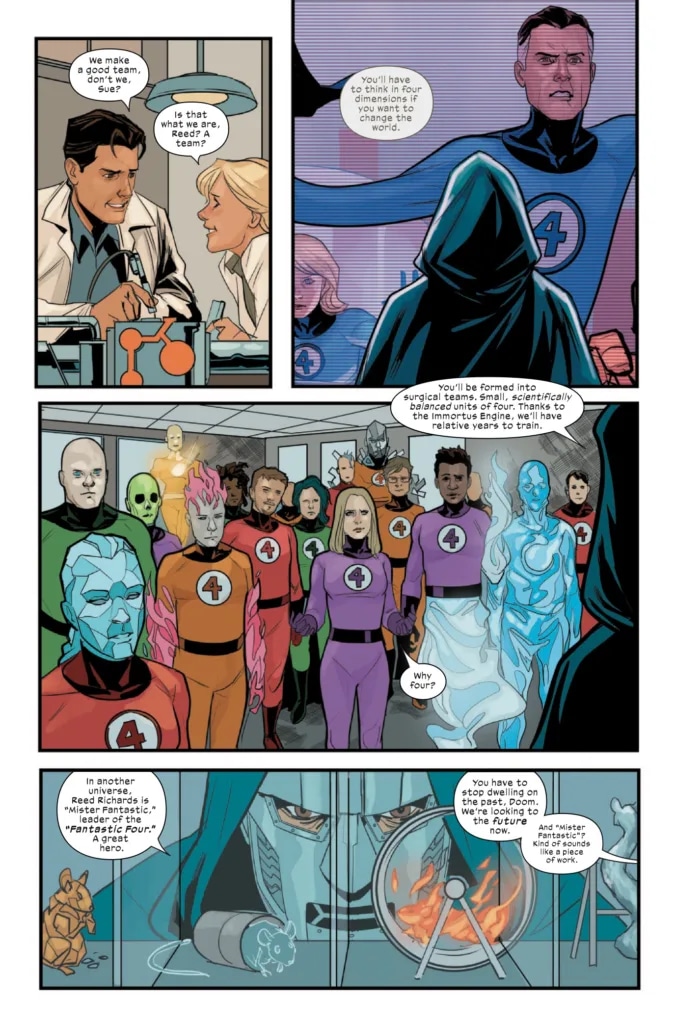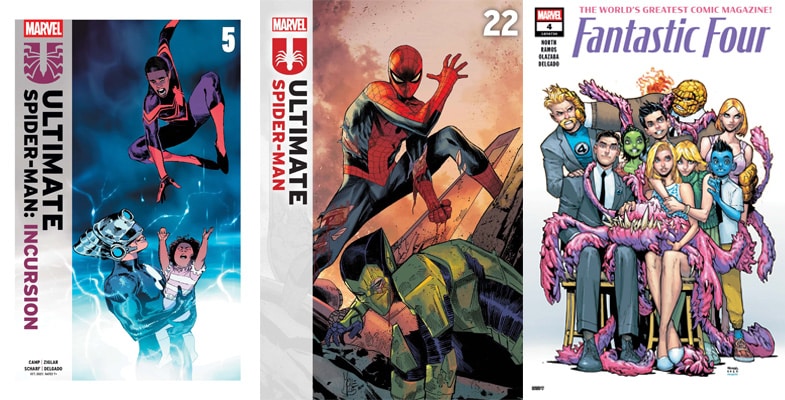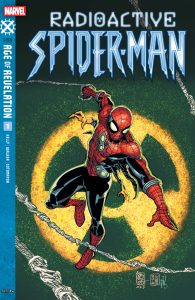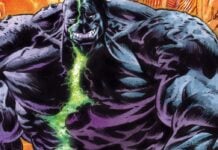Face Front, True Believers! It’s another marvelous Wednesday and that means its time for The Marvel Rundown. After a heavy dose of Revelation last week, this week we have a Rundown filled to bursting with stories from across the Marvel Multiverse. First we turn a spotlight on a moving cross-time tragedy in The Ultimates #17. and in the rapid rundown we take a look at Ultimate Spider-Man #22, and more Dispatches from the Age of Revelation.
As always, The Beat wants to hear from you, True Believers! Tell us what you think of this week’s Marvel Comics! Shout us out in the comment section below or over on social media @comicsbeat, or @comicsbeat.bsky.social, and let us know.
The Ultimates #17
Writer: Deniz Camp
Artist: Phil Noto
Letterer: VC’s Travis Lanham

The Ultimates has been Marvel’s best book almost since the moment it launched but if there is one criticism that can be levied against the title, it is that the series focuses more on its plot and themes than characters. Part of that is the nature of the whole Ultimate line with its ambitious realtime monthly publishing schedule, with each new issue taking place the month it released. It leaves the whole line of books feeling disjointed. Without having the space to sit with individual characters in depth, and large chunks of their adventures occurring off-page, the characters are pretty thinly defined. There are exceptions of course, and one of The Ultimates’ best issues was its fourth, a story focused narrowly on Ultimate Doom, Reed Richards, and his history. Not only was it a moving exploration into the character’s tragedy, it was ambitiously structured and beautifully drawn by Phil Noto. That focus on the character and his motivations has allowed Doom to become one of the most well defined and interesting figures in the new Ultimate line.
With word now official that the Ultimate Universe is ending, each issue of this series feels all the more precious, and I was eagerly anticipating Deniz Camp reuniting with Noto on a follow up to that now-classic fourth issue. #17 starts out repeating that earlier issue’s narrative structure of four individual but interconnected narratives stacked vertically on each page. But as Doom’s emotional journey unfolds, as his past breaks in on his present and the Maker looms, the patterns break down. There is no longer a simple rigid structure of four latticed panels. The past and present intermingle. Absences of what might have been haunt the pages, bringing the white space of the gutters into the panels.
Like the patterns on the page, we can break the patterns of self hatred and self pity, of fear and disillusionment and isolation. Forge something new and full of hope in its absence. To live—free—is a choice we can make, even in the face of tragedy or pain. We can choose a new way to approach hardships, one born of those pains but not limited by the past.
Through Doom’s harrowing journey of loss, torture, self-loathing, and grief, all existing on the page at one time, Camp and Noto make physical the sensation of memory and perception of past and present as a single unit that defines us with every breath. It is one of the beautiful things comics allows, this juxtaposition of time. We see cause and effect simultaneously. The past is always right there, as real as the panel in front of you. VC’s Travis Lanham’s lettering smartly and subtly transcends the panels and timestreams, intercutting the multiple narratives on the page and forcing the reader to absorb the multiple stories as a single unit, even on second or third readings focused on individual moments, as the balloons float over multiple panels.
No one in comics is better at the subtle nuance of facial expression and body language than Phil Noto. As good as the series’ regular artist is, these Doom-centered issues demand a touch of subtlety and precision. Doom must sell his years of pain with nothing but a glimpse of his eyes, the turn of his head or slouch beneath his cape. Noto’s choice of color is notable as well, the issue is largely washed out, with monochrome blues and grays capturing the hopeless mundanity of Doom’s daily flagellation. In the end, it is a gash of bright red from an unsuspecting colleague that snaps Doom out of his torpor, bringing unexpected warmth and light slashing through his gray world.
It is these final moments that take this issue from compelling to great. A single panel, really, a shot of Reed’s eyes behind the expressionless armor, and a single word balloon. It radically shifts everything. And it’s a gift to this reader, who has wrestled with feelings of “brokenness” and the nagging sense for much of my life that something was just missing. Camp and Noto bring readers on a journey with Reed Richards that ultimately invites him to let go of the single driving obsession in his life. It is a story not about giving up on your goals but not letting loss and failure define you. It is about moving beyond the mourning what you might have been if you were healthy or born at a different time or in a different place or a world that doesn’t feel so broken. It is about the power of letting yourself hope that a brighter future may be awaiting on the horizon, not in spite of that ever-haunting-ever-present-past, but fueled by them to define who you can be in the here and now, in this panel, not who you’ve been.
VERDICT: BUY. The Ultimates #17 is the best issue of one of the best superhero comics of the year.
The Rapid Rundown
- Ultimate Spider-Man #22
- Ultimate Spider-Man #22, written by Jonathan Hickman and illustrated by Marco Checchetto, is a strange issue. It feels like an issue #23 rather than an issue #22, especially after issue #22’s explosive finale, which led to the death of the Mysterios, Gwen Stacy, and caused Peter and his family to abandon another home. Such an insane cliffhanger issue feels like it needs a proper follow-up that really shows the depths of the Ultimate version of these characters. However, issue #22, in keeping with the monthly narrative structure, which is starting to show its weaknesses in these later issues, time-jumps a month ahead so the fallout of the last issue is resolved off-screen. We don’t see Harry’s reaction to Gwen’s death, Peter’s family’s response to losing their homes, or even the reaction of Black Cat to her own father’s death before we move on to other things. Instead, we get a “family dinner,” which feels slightly out of place, and the characters almost act like nothing significant has just happened. There’s, as usual, a lot to like about Ultimate Spider-Man; these new interpretations of characters and plotlines are so interesting that they warrant a pick-up. There’s even a cute scene between Peter and MJ, even if this interpretation of their relationship has gotten stale. And if you’ve been reading Ultimate Spider-Man from start to finish, you at least want to see how it all comes together in the end, but it’s hard to ignore the elephant in the room. Ultimates is closing, and this issue feels like it’s rushing to tie up plotlines or ideas that Hickman conceptualized before the whole universe comes to an end. Hopefully, the move to rush things doesn’t cause the rest of the issues to crash and burn. – LM
- Ultimate Spider-Man: Incursion #5
- The last few weeks have revealed that the current Ultimate Marvel line is coming to a close. Creatives have reported being flabbergasted why this is happening and they have a right to be. Right now, Ultimate Marvel is keeping the company afloat creatively. These books are taking bolder chances than most of the current mainline. So seeing them go seems like a shame. Then again a book like Ultimate Spider-Man: Incursion, wrapping up with issue 5 may show that this might be a good idea. Co-writers Deniz Camp and Cody Ziglar sent Miles Morales on a world tour of this Earth-6160 looking for his baby sister. What offered the tantalizing possibility that this might be how the Maker escapes from his city. Instead just ties up the loose end from Ultimate Invasion which was if Miles would end up on Earth-6160. So much of these five issue were about Miles’ sister maybe being a key to something but no, she’s just a baby. There’s been the subplot of Miles getting his memories back of the original Ultimate Universe after spending time here and Doom finally learning why The Maker was so obsessed with him. These things would feel impactful except they will be fully explored in those characters own books. Who knows if what Miles brings back to the main Marvel Universe will ever be seen again or have any real consequence. So why bring Miles into this new world at all? How was this an own self contained story if it exists only to set up other stories rather tell a meaningful one in its own right? When the original Ultimate line was announced, Joe Quesada said if it crossed over with the main books then they’d run out of ideas. When crossover happen towards the end of the original Ultimate line’s conclusion, Spider-Man met Miles Morales. That Miles Morales once again appears before the end of this Ultimate universe, might signal they’ve run out of ideas here too. – DM
- The last few weeks have revealed that the current Ultimate Marvel line is coming to a close. Creatives have reported being flabbergasted why this is happening and they have a right to be. Right now, Ultimate Marvel is keeping the company afloat creatively. These books are taking bolder chances than most of the current mainline. So seeing them go seems like a shame. Then again a book like Ultimate Spider-Man: Incursion, wrapping up with issue 5 may show that this might be a good idea. Co-writers Deniz Camp and Cody Ziglar sent Miles Morales on a world tour of this Earth-6160 looking for his baby sister. What offered the tantalizing possibility that this might be how the Maker escapes from his city. Instead just ties up the loose end from Ultimate Invasion which was if Miles would end up on Earth-6160. So much of these five issue were about Miles’ sister maybe being a key to something but no, she’s just a baby. There’s been the subplot of Miles getting his memories back of the original Ultimate Universe after spending time here and Doom finally learning why The Maker was so obsessed with him. These things would feel impactful except they will be fully explored in those characters own books. Who knows if what Miles brings back to the main Marvel Universe will ever be seen again or have any real consequence. So why bring Miles into this new world at all? How was this an own self contained story if it exists only to set up other stories rather tell a meaningful one in its own right? When the original Ultimate line was announced, Joe Quesada said if it crossed over with the main books then they’d run out of ideas. When crossover happen towards the end of the original Ultimate line’s conclusion, Spider-Man met Miles Morales. That Miles Morales once again appears before the end of this Ultimate universe, might signal they’ve run out of ideas here too. – DM
Dispatches from the Age of Revelation!
- Radioactive Spider-Man #1
- For a very brief time, Joe Kelly wrote X-Men under the micromanaging eye of editor Bob Harras. His too brief run saw him team up with future Man of Action collaborator Steven T. Seagle and both left the book after constantly being forced to change stories to appease Harras. During this run, one of the characters Kelly focused on was mutant doctor Cecilia Reyes, the reluctant X-Person. So when writing a part of the Age of Revelation crossover, it’s somehow not surprising that he returned to the character in Radioactive Spider-Man. More surprising is seeing her as his current romantic partner. But honestly, that’s about all that’s intriguing in this mini-series. This is the kind of story that screams for a more horror oriented take. Peter Parker, in an effort to curb the effects of the X-Virus, has exposed himself to higher and higher doses of radiation in the last ten years. Naturally he’s mutated further but it’s hard to tell if artist Kev Walker pulled back or Marvel didn’t want a full on body horror comic. Regardless, this mutated version looks rather tame. When an animated cartoon fully commits to Spider-Man as Man-Spider than the comics, you know you’re probably in for a skippable tie-in mini-series. – DM
- X-men: Book of Revelation #1
- Let’s get this out of the way, the plot structure for Age of Revelation is a weird one. The plot stretches over different disparate tie-ins with varying levels of interconnectivity. This mostly works fine as it helps build up this hellscape, but it makes it hard to recommend which books to read for the “plot”. Seemingly the plot looks to be Revelation has angered Apocalpyse on Arrako and their looks to be a war on the horizon, while the X-men attempts to assassinate Revelation before the war breaks out. Ultimately it feels that when it comes to Age of Revelation, the definitive books to follow are the ones penned by Jed MacKay. As evidence by Book of Revelation #1 focusing on the inner circle of Revelation dealing with the fallout of the events from X-Men: Age of Revelation Overture. We get a lot of palace intrigue stories as writer Jed MacKay focuses on known scumbag and current #1 Chorister Fabian Cortez manipulating those around him to keep himself useful. If Amazing X-men is the main X-men book, Book of Revelation is much like Immortal X-men book from Krakoa. There is a lot of backstabbing and politicking as Apocalypse’s son Death shows back up in this issue, and we see the tenuous peace between Earth and Arrako unravel. Frankly, it is a welcome surprised to see more elements from Krakoa come back for the finale of the From the Ashes era. Artist Netho Diaz plays around with a formal gride overlay on the pages that gives the pages a uniform look but doesn’t do much the pages in terms of the narrative. It still looks aesthetically pleasing. I love Diaz’s rendering of Cortez. He plays around with the traditional heroic posing with Cortez but subverts it by Cortez’s sliminess. The story is engaging and a welcome look into the inner workings of the Age of Revelation. I recommend checking this one out for those following this event. –JJ

















